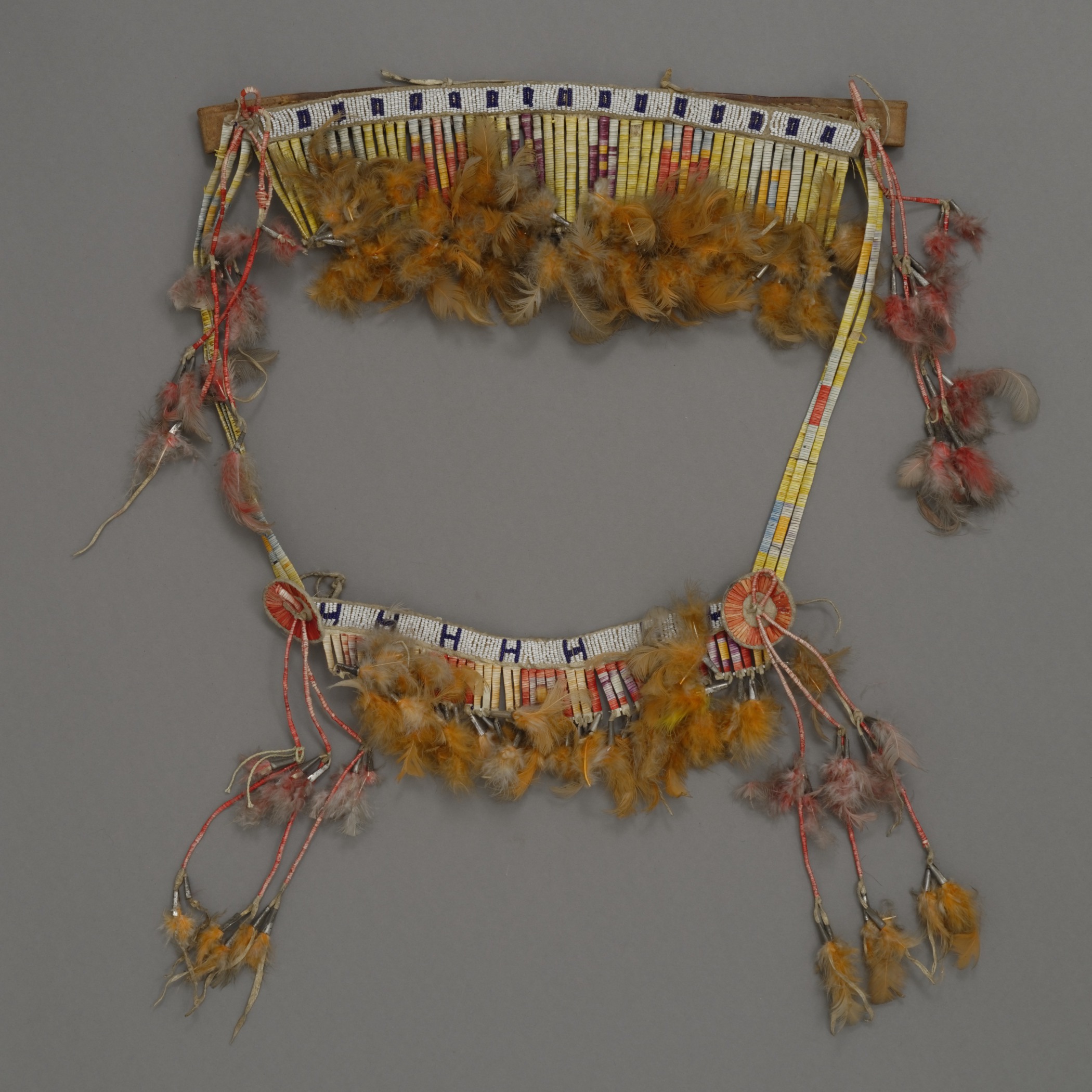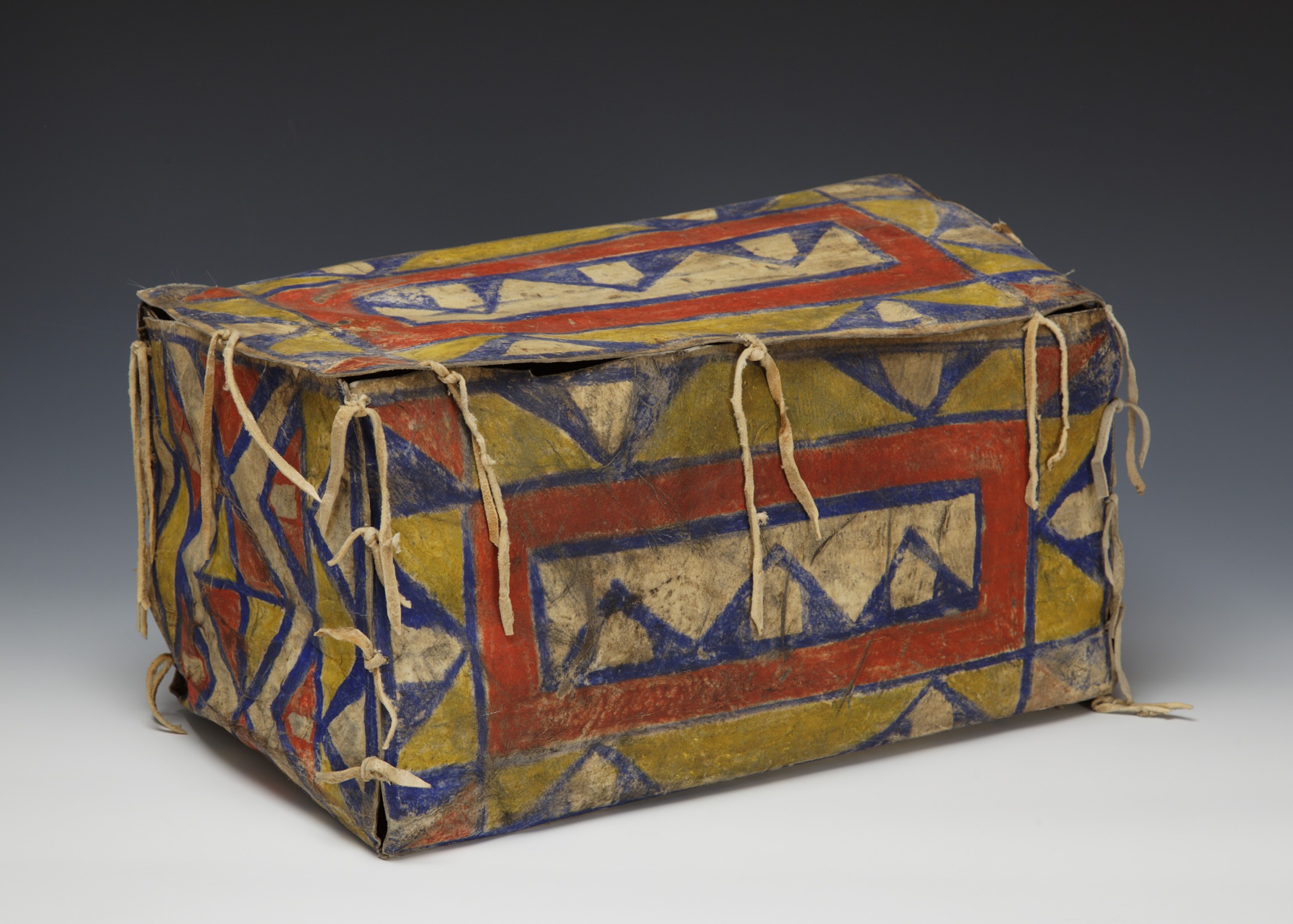Unknown people (Plains)
Model tipi
- Collected about 1943-1960
- Buckskin, wood, floor tile, and paint
- 5 13/16 × 5 × 5 1/8 in.
Hood Museum of Art, Dartmouth College: The Wellington Indian Doll Collection, Gift of Barbara Wellington Wells; 987.35.26868
visibilityLook & DiscussA tipi is a cone-shaped tent made of animal skin stretched over wooden poles. Tipi is a Sioux word that means “used to live in.” The tipi was uniquely suited to serve the needs of nomadic Plains cultures.
This model of a tipi imitates the structure and materials used in actual tipis.
explore the object
Unlike other conical tents, tipis have smoke flaps at the top that allow for an indoor fire. Tipis were designed to be set up and taken down easily as groups moved from place to place. When taken apart, the tipi poles were used for a travois (trah-VWAH), or sled, first pulled by domesticated dogs and later by horses. Additional poles and the tipi cover were placed on the travois. Some tipis were covered in deer or elk hide. Others were covered in buffalo skin. Later, tipis were covered in canvas acquired in trade.
Sioux, figure of a Sioux dog and travois, 1957. Fur, glass trade beads, wood, and string leather, 3 9/16 × 1 1/8 × 5 5/8 in., 7 1/8 × 13 9/16 in. Hood Museum of Art, Dartmouth College: The Wellington Indian Doll Collection, Gift of Barbara Wellington Wells; 987.35.26828.
Lena Brown, American (Inunaina), born 1892 , doll representing an Inunaina woman, child, and horse, 1946. Glass trade beads, buckskin, horsehair, wood poles, string, and metal wire, 3 3/16 × 2 7/16 × 7 7/8 in. Hood Museum of Art, Dartmouth College: The Wellington Indian Doll Collection, Gift of Barbara Wellington Wells; 987.35.26800.
Tipis provided shelter and privacy for a family. Women were responsible for setting them up and taking them down. The poles, called lodge poles, were anywhere from 12 to 25 feet long. To erect a tipi, the female members of a family first lashed the poles together at what would be the top end, and raised them upright with a twist so the poles would cross. They would then pull the opposite ends of the poles apart into a circle about 10 feet in diameter. Next, they would take hides, which they had sewn together into a semicircular shape, draw them around the poles, and lash them together. They used rawhide, and later rope, to bind the tipi together. They secured the lower edges of the hides to the ground with tent pins. The women would attach an extra skin to the top and left it open on the windward side to help smoke exit. They would also leave a low opening for a doorway, covering it with an extra skin. They would place a fire pit in the center, and arrange hides and bedrolls around the edges.
Most tipis were not decorated. Those that were painted were decorated by men with scenes of noteworthy battles, celestial images, or personal experiences, like a hunting feat, dream, or vision.
This tipi is painted reddish-brown with yellow dots. A blue cross appears on the back. The door flap is in the shape of a beaver.
Today, tipis are rare, and constructed for ceremonial occasions.
Explore Related Objects
Chief Killer (Noh-hu-nah-wih), Southern Tsistsistas, 1849–1922, Untitled (“Cheyennes on a visit to the Sioux”), page 37 from a Chief Killer sketchbook, about mid-1875–mid-1878. Graphite, colored pencil, and red ink on wove sketchbook paper, 8 5/8 × 11 1/4 in. Hood Museum of Art, Dartmouth College: Mark Lansburgh Ledger Drawing Collection; Partial gift of Mark Lansburgh, Class of 1949; and partial purchase through the Mrs. Harvey P. Hood W’18 Fund, and the Offices of the President and Provost of Dartmouth College; 2007.65.22.
This drawing by Tsistsistas (Cheyenne) artist Chief Killer shows a Sioux encampment with several tipis. Some of the tipis are plain and some are painted. In the lower right, a group of visiting Tsistsistas cook and rest in two “see-through” tipis.
Hunkpapa Lakota, tipi liner depicting Cehupa’s (Jaw) exploits, about 1910. Muslin, paint, porcupine quills, rawhide, native-tanned hide, cotton cloth, tin cones, dye, wool yarn, ink, string, and thread, 34 13/16 × 147 1/4 in. Hood Museum of Art, Dartmouth College: Purchased through the Mrs. Harvey P. Hood W’18 Fund; 2009.10.
Firelight inside a tipi casts every person’s shadow on the tipi wall at night. In order to maintain some privacy from the outside world, an inner wall, or tipi liner, is tied close to the outer skin, absorbing the shadows, helping with ventilation, and brightening the interior space with color.
This tipi liner depicts scenes of Lakota life, including horse raiding, courtship, and the Sun Dance, a sacred Plains tradition.
Unknown people (Plains), 26 tipi ornaments, early 20th century. Commercial leather, quills, metal, and horsehair, 5 7/8 × 13/16 in. Hood Museum of Art, Dartmouth College: Gift of Guido R. Rahr, Sr., Class of 1951P; 985.47.26614.
Lakota (Teton Sioux), tipi bag (possible bag), about 1890–1910. Buffalo (American bison) hide, glass beads, metal (tin) cones, sinew, cloth, string, and dyed horsehair tufts, 15 1/4 × 19 1/4 × 1 1/2 in. Hood Museum of Art, Dartmouth College: Gift of Robert G. Sands, Class of 1959, Tuck 1960; 2010.45.
Ornaments like these appear at the upper edge of the tipi liner. They added color and beauty to the interior of the tipi.
Items within the tipi were stored in buffalo-hide bags like this one. They were often called “possible bags” by collectors and traders. The name derives from the Lakota term that literally translated means “a bag for every possible thing.”
learn more
In this video, A’aaninin (Gros Ventre) curator Joe Horse Capture discusses this tipi liner and the history of drawing on the Plains.
The tipi has been misrepresented again and again as the shelter used by all Native American groups. In fact, only Plains cultures constructed tipis. To learn more about widespread stereotypes and get answers to many of the most common questions about Native American culture, read Do All Indians Live in Tipis, a resource written by the National Museum of the American Indian.




